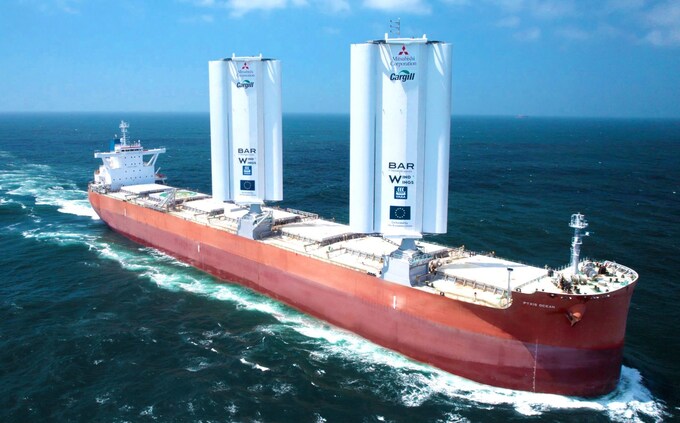|


256-bit encryption
$500,000 protection

|
PYXIS OCEAN
Mitsubishi’s
80,000-ton Pyxis
Ocean bulk carrier is the world’s first wind-powered
freighter. She embarked on her maiden voyage on August
20th, 2023,
from Shanghai to Singapore.
Getting to the first voyage has not been easy. Cargill
initially trialed kites but found they simply did not
work and subsequently joined forces with
Portsmouth-based BAR Technologies for the WindWings
project.
Placing
the huge cambered aerofoils on the deck hampered
visibility from the bridge, forcing the team to install
cameras to see ahead. They also needed to build in a
tilting mechanism that enabled the sails to be stowed
during dockside operations, when passing under
structures, or in stormy sea conditions.
In yachting, the size of the sail can be made smaller to
cope with heavy weather, so engineers had to come up
with a similar way of depowering the wings in case of a
sudden storm. As well as being able to pivot, each wing
has three moveable elements that can be adjusted to
spill the wind or exploit its power, in the same way
that an aircraft wing changes its shape during take-off
and landing.
Wind sensors on board pick up wind angle and speed,
automatically reorienting the sail in the event of
unexpected gusts. Above 40 knots – gale force conditions
– the wings can be folded onto the deck. There are also
sensors which detect the lean – or heel – of the ship,
how far it is drifting off the set course and the rudder
angle.
Digital projections show they should deliver enough
propulsion to cut the ship’s fuel use by at least three
tones per day – about 30 per cent – helping to
decarbonize the shipping industry without having to
scrap existing vessels.
The technology could change current shipping routes,
making it more profitable to follow the old trading
routes with favourable winds, rather than travelling in
the straight lines most cargo ships do today.
If
successful hundreds more ships will be retrofitted with
the wings.

We build this
primarily wood model of the Pyxis Ocean the following
sizes:
26" long (1/350 scale)
45" long (1/200 scale)
62" long (1/144 scale)
90" long (1/100 scale)
Please contact us for prices and lead
times.
|